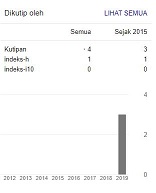Assessing the Performance of Public Sector Entities in Nepal: A Cash Flow Ratios Perspective
Abstract
Keywords
Full Text:
PDFReferences
Albrecht, W. S. (2003). Fraud Examination Mason, Ohio, Thomson and South- Western.
Atieh, S. H. (2014). Liquidity analysis using cash flow ratios as compared to traditional ratios in the pharmaceutical sector in Jordan. International Journal of Financial Research, 5(3), 146-158.
Bashir R., & Regupathi A. (2021). Aggregate and disaggregate measures of operating and non-operatingworking capital influence on firm performance: Evidence from Malaysia. International Journal of Bankingand Finance, 17(2): 1–26.
Berry, A., Jarvis, P., & Jarvis, R. (2005). Accounting in a business context. London.
Carslaw, C. A. & Mills, J. R. (1991). Developing ratios for effective cash flow statement analysis. Journal of Accountancy, 172(5), 63.
Catanach, H.A. (2000). An empirical study of operating cash flow usefulness in predicting savings and loan financial distress. Advances in Accounting, 17(1), 1-30.
Cooke, B. & Jepson, W.B. (1986). Cost and financial control for construction firms. Macmillan Educational, London.
Das, S. (2019). Cash flow ratios and financial performance: A comparative study. Accounting, 5(1), 1-20.
Everingham, G.K., Kleynhans, J.E. & Posthumus, L.C. (2003). Introductory GAAP.3re Ed. Juta: Landsdowne.
Fabozzi., F. J. & Markowitz, H. M. (2002). The theory and practice of investment. Asset Allocation, Valuation, Portfolio Construction, and Strategies 2nd Edition
Farshadfar, S., Ng, C., & Brimble, M. (2008). The relative ability of earnings and cash flow data in forecasting future cash flows. Pacific Accounting Review, 20(3), 254-268.
Figlewicz, R.E. & Zeller, T.L. (1991). An analysis of performance, liquidity, coverage and capital ratios from the statement of cash flow. ABER, 22(1), 64-81.
Giacomino, D.E. & Mielke, D.E. (1993). Cash flows: another approach to ratioanalysis. Journal of Accountancy, 175(3), 55-58.
Gup, B.E. Samson, W.D. Dugan, M.T. Kim, M.J. & Jittrapanun, T. (1993). An analysis of patterns from the statement of cash flows. Financial Practice and Education, 7(1), 3-79.
Helen, K. (2002). The effect of lenders decision. The International Journal of Accounting, 37(3), 347- 362.
Hertenstein, J. H. & McKinnon, S. M. (1997). Solving the puzzle of the cash flow statement. Business Horizons, 40(1), 69-77.
Kaka, A.P. & Price, A.D.F. (1991). Net cash flow models: are they reliable? Construction Management and Economics, 9(3), 291-308.
Kenley, R. (2003). Financing Construction: Cash flows and Cash Farming, Spoon Press, London.
Kenley, R. & Wilson, O. (1986). A construction project cash flow model: an ideographic approach. Construction Management and Economics, 4 (3), 213-32.
Kroes J. R. &Manikas A. S. (2014). Cash flow management and manufacturing firm financial performance: A longitudinal perspective. International Journal of Production Economics. 148, 37–50.
Macve, R. (1997). A conceptual framework for financial accounting and reporting. New management. New York: Wiley.
Mills, J. & Yamamura, J. H. (1998).The power of cash flow ratios. Journal of Accountancy, 186(4), 53-62.
Mossman, C.E. & Bell, G.G. & Swartz, L.M. (1998). An empirical comparison of bankruptcy models. Financial Review, 33(2), 35-55.
Neill, J. D., Schaefer, T. F., Bahnson, P. R., & Bradbury. M. E. (1991). The useful of cash flow data: a review and synthesis. Journal of Accounting Literature. 10(1), 117-150.
Nepal Electricity Authority, Kathmandu. Annual Reports 2020/2021 to 2022/2023.
Nepal Oil Corporation Limited, Kathmandu. Annual Reports 2020/2021 to 2022/2023.
Nepal Telecom Limited, Kathmandu. Annual Reports 2020/2021 to 2022/2023.
Nguyen, H.A., Pham, T.H., & Nguyen, T.H. (2020). Impact of working capital management on firm’s profitability: empirical evidence from Vietnam. Journal of Asian Finance, Economics and Business, 7(3), 115-125.
Oxley, R. and Poskitt, J. (1996). Management techniques applied to the construction industry. 5th ed., Blackwell Science, Oxford.
Palepu, K.G., Healy, P.M. & Bernard, V.L. (2000). Business analysis & valuation. Using financial statements, City, OH: Thompson Learning.
Ravinder, Donthi. (2015). Financial Analysis – A Study. London. Journal of Economics and Finance,2 (3). 10-22.
Ross, S., Westerfield, R., & Jordan, B. (2007). Fundamentals of Corporate Finance. 5th ed. McGraw-Hill.
Rujoub, M.A., Cook, D.M. & Hay, L.E. (1995). Using cash flow ratios to predict business failures. Journal of Managerial Issues, 7(1), 75-91.
Salehi, M., Yekta, M. B., & Ranjbar, H. R. (2018). The impact of changes in cash flow statement items on audit fees: Evidence from Iran. Journal of Financial Reporting and Accounting, 18(2), 225-249.
Tarquin, A.J. and Blank, L.T. (1976). Engineering Economy: A Behavioral Approach, McGraw-Hill Book Company, New York, NY.
Zeller, T.L. & Stanko, B.B. (1994). Operating cash flow ratios measure a retail firm’s “ability to pay”. Journal of Applied Business Research, 10(4), 51-60.
DOI: http://dx.doi.org/10.53712/jmm.v9i2.2791
Refbacks
- There are currently no refbacks.
Indexing:
Aliansi:
Reference Manager:
View Statistic
Published by Prodi Manajemen Fakultas Ekonomi Universitas Madura
Jl. Raya Panglegur Km 3,5 Pamekasan
Phone: (0324) 322231
website: http://ejournal.unira.ac.id/index.php/jurnal_makro_manajemen/index
Email: makro@unira.ac.id
MAKRO by Universitas Madura is licensed under a Creative Commons Attribution 4.0 International License.







